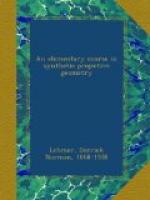167. Desargues had no conception of the conic section of the locus of intersection of corresponding rays of two projective pencils of rays. He seems to have tried to describe the curve by means of a pair of compasses, moving one leg back and forth along a straight line instead of holding it fixed as in drawing a circle. He does not attempt to define the law of the movement necessary to obtain a conic by this means.
168. Reception of Desargues’s work. Strange to say, Desargues’s immortal work was heaped with the most violent abuse and held up to ridicule and scorn! “Incredible errors! Enormous mistakes and falsities! Really it is impossible for anyone who is familiar with the science concerning which he wishes to retail his thoughts, to keep from laughing!” Such were the comments of reviewers and critics. Nor were his detractors altogether ignorant and uninstructed men. In spite of the devotion of his pupils and in spite of the admiration and friendship of men like Descartes, Fermat, Mersenne, and Roberval, his book disappeared so completely that two centuries after the date of its publication, when the French geometer Chasles wrote his history of geometry, there was no means of estimating the value of the work done by Desargues. Six years later, however, in 1845, Chasles found a manuscript copy of the “Bruillon-project,” made by Desargues’s pupil, De la Hire.
169. Conservatism in Desargues’s time. It is not necessary to suppose that this effacement of Desargues’s work for two centuries was due to the savage attacks of his critics. All this was in accordance with the fashion of the time, and no man escaped bitter denunciation who attempted to improve on the methods of the ancients. Those were days when men refused to believe that a heavy body falls at the same rate as a lighter one, even when Galileo made them see it with their own eyes at the foot of the tower of Pisa. Could they not turn to the exact page and line of Aristotle which declared that the heavier body must fall the faster! “I have read Aristotle’s writings from end to end, many times,” wrote a Jesuit provincial to the mathematician and astronomer, Christoph Scheiner, at Ingolstadt, whose telescope seemed to reveal certain mysterious spots on the sun, “and I can assure you I have nowhere found anything similar to what you describe. Go, my son, and tranquilize yourself;




